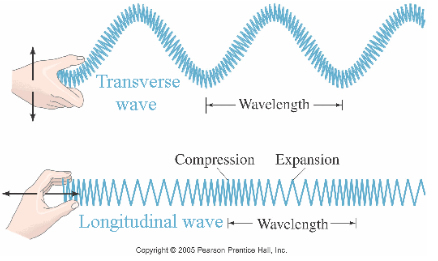Light and Sound - Grades 3-5
Option 2 - Playing Around with Light & Sound
Nebraska Science Standards
5.2.3.a Recognize that sound is produced from vibrating objects; the sound can be changed by changing the vibration
5.2.3.b Recognize that light travels in a straight line and can be reflected by an object (mirror)
5.2.3.c Recognize that light can travel through certain materials and not others (transparent, translucent, opaque)
Objective: The objective of this activity is to provide hands-on demonstrations that help students to understand the properties of light and sound.
Materials (provided by CSM):
- Wave demonstration
- Slinky
- Prism & Flashlight
- Laser Pointer & Mirror
- Tuning Forks
- Tuning forks
- Baking pans
- Water
Set up:
- Set up stations before discussion if possible (ensure stations are not at the student's’ desk --- the floor or extra activity tables work great)
- Take ~20 mins to introduce yourself and go through the discussion points below
- Demo slinky during discussion
- Break students into groups and explain the following: do not shine the laser in someone's eyes, be careful not to twist the slinky, be respectful and take turns. Make sure the students know if at any time the rules are not followed we will have to stop the activity (but say it in a nice way)
Discussion:
- Why is it important for scientists to study light and sound?
- Light allows us to see our world and perceive visual information. Sound allows us to hear and communicate.
- How do sound waves travel? How do light waves travel? What’s the difference?
- Sound travels in the form of vibrations. For example, when someone picks a guitar string, the string vibrates and produces a sound. The sound produced travels in a longitudinal or compression wave. The volume and pitch of a sound depends on its amplitude and frequency.
- Light travels in “energy packets” called photons. Photons look like waves. Light travels in transverse waves. These waves are like ocean waves- they go up and down. The reason why we are able to see is because light bounces off the surface of an object to our eyes.

Wave Demonstration:
Transverse waves: Chose two students to help you with the demonstration. Have each student hold one end of the slinky. One student will gently make an up-and-down motions with his/her hand. These waves are light waves.
Compression waves: Chose two other students to help with the demonstration. Set up the slinky on a solid surface either a long table or a tile floor. The students should be a little bit closer as does not move as easily this way. Have one student push the slinky towards the other helper without letting go. These are sound waves.
Discussion Cont:
- What is the difference between reflection and refraction of light?
- Reflection occurs when light bounces off objects.
- If light bounces off a smooth surface, the light will bounce off at equal angles, such as a mirror or water.
- Refraction occurs because light bends.
- Light bends as it passes from one substance to another. Imagine a glass of water with a straw. The straw appears to be bent because the light passes from the air to the water.
- Reflection occurs when light bounces off objects.
- How do we see color?
- Absorbed light is taken in and not reflected. A red apple appears red because it absorbs all the other colors and reflects red.
- How is a rainbow formed?
- As light passes through a prism it bends light (refraction) and is reflected back to your eyes as a rainbow. Raindrops act like tiny prisms.
- How fast does light from the sun get to the earth?
- 499 seconds for light from the sun to travel to earth, which is about 8 minutes and 20 seconds.
- How do we see light?
- Light passes through the cornea, pupil, and lens before hitting the retina. The iris controls the size of the pupil. In a dark room the iris gets smaller, allowing the pupil to dilate. In a bright room or outside the iris gets bigger, which does not let as much light pass through.
- What speed does light travel?
- 186,282 miles per second! That’s like running around the entire Earth in 7.5 seconds! In theory, nothing travels faster than light.
- Why do we hear sounds at different pitches?
- Different pitches are caused by different frequencies in sound waves. The bass, drum and tuba have low frequencies. Chirping birds and playing the triangle of high frequencies.
- Vibrations are detected in the ear.
- What speed does sound travel?
- Sounds travels at 1,125.33 feet per second at standard regulations in the air. Remember that sounds travels at different speeds depending on that matter it travels through: air, solid, or liquid.
Activity 1 Station:
*Ensure students know not to point laser pointer in someones eye -- if it happens the activity will be over* -- Ensure students take care with slinky so it doesn't get tangled.
Purpose of activity:
Students experiment with refraction- the bending of light through different mediums and reflection- light bouncing off objects.
Procedure:
- Allow the students to play around with the items at the station
- Prism and flashlight can be used to “bend” white light (refraction) and make rainbows
- Laser pointer and mirror can be used to “bounce” the light (reflect) onto another object
- Slinky can be used to demonstrate both sound and light waves.
Activity 2 Station (might need 2 stations depending on class size):
Tuning Forks
Purpose of activity:
- Students brainstorm and hypothesize about pitch and frequency. High pitches move faster, low pitches move slower
High pitches:
- Ex: Flute, Violin, Birds chirping, Sirens/alarms
Low pitches:
- Ex: Tuba, Bass clef instruments, Bear/lion roar, A hungry stomach
Set up: Put water about 1 ½ inches deep in each pan, place paper towels under the pans to reduce water mess
Procedure:
- Let the students hypothesize what size of tuning fork will have a high sound and low sound.
- Then let them experiment by gently tapping the tuning fork on the edge of their desk or the palm of their hand.
- Have them notice the fork shaking as it produces the sound.
- Have them put it a few inches from their ear and notice the sound -- is it high pitch or low pitch? --what do you think it looks like?
- Then have them tap the fork again, but this time have them put it in the water. What do they see? **only the end of the tuning fork should be placed in the water, it should NOT be submerged or else the experiment won’t work -- the intended result is to see the waves/ripples go out from the fork-- waves correspond to pitch/frequency







